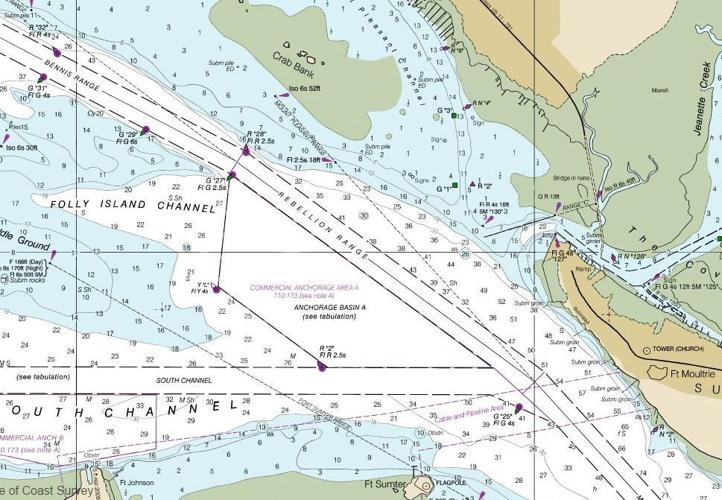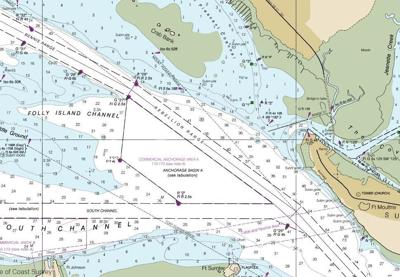A lead article in the Saturday, Jan. 14, 2017, issue of the Post & Courier discussed the possibility of cruise ships anchoring off Mount Pleasant and ferrying passengers to Patriots Point. Town Councilman Gary Santos (who hopefully has a good sense of humor) called the idea “groundbreaking,” which gave me a chuckle since this particular “ground” is as wet as one can get.
The anchorage, which lies between Fort Sumter and Crab Bank, is known as “Commercial Anchorage A.” Historically, it has a more intriguing name, Rebellion Roads — “roads” being a nautical term for a safe anchorage. Ships of every size, shape, flag and feature have anchored at Rebellion Roads since the founding of Charleston. The only time this wasn’t a particularly safe spot was during the Civil War, when the Confederates placed seven large boiler-iron torpedo mines in the water there to keep Union ironclads from creeping in “under the cover of partial darkness or a fog” and using the position to attack Forts Sumter and Moultrie. (For Civil War buffs, this information was found in the Official Records, Correspondence, Feb. 21, 1862, and Johnson’s “The Defense of Charleston Harbor.")
This is also generally the same area where the British fleet attacked Fort Sullivan in 1776. Yet the name “Rebellion Roads” originated long before the American Revolution, dating to Charles Town’s earliest days. It was so named because a vessel could anchor here and still be out of reach of the few guns that then fortified the city. A vessel could defy or, using the archaic term, be “in rebellion” with the laws requiring incoming ships to present themselves and their intentions to the authorities. Normal trading vessels had no issues with these laws. Those involved with piracy or illegal privateering used the place to their advantage.

Riding at Rebellion Roads.
One memorable instance of this type of “rebellion” happened in April 1692, when the “Loyall Jamaica,” a privateering vessel under the command of Captain George Raynor, anchored in Rebellion Roads for days without informing the authorities of their purpose. The townsfolk were nervous; pirates were about. Those aboard the “Loyall Jamaica” also had reason for concern. They could be tossed into jail (or hanged) as pirates rather than be acknowledged as legal privateers. It was a dicey situation for both.
The problem was this: The “Loyall Jamaica” had, in fact, been sailing with a Letter of Marque, the legal okay to engage in privateering, but what they’d been doing wasn’t exactly on the up and up.
Raynor and his crew were among the first privateers-cum-pirates known as the Red Sea Men, those who preyed on the ships carrying wealthy Arabs bound for Mecca laden with silver, gold, and precious jewels for the Grand Mogul. On just one raid, Raynor and his crew had gotten so much booty each crewmember’s take was £1,100, somewhere around a half million dollars today. The “Loyall Jamaica” was heading home with a hold filled with booty.
Much has been written about the “Loyall Jamaica” by historians, including myself. I recently did some deep re-probing into the vessel’s history. I was particularly interested because some crewmembers settled in Christ Church Parish (today’s Mount Pleasant) and became stellar planters and citizens.
One confusion was that some of the crewmembers had the same last names of people already settled in the Lowcountry. Daniel Horry was on the ship, as was Francis Blanchard and John Palmer. All three came from families who had been in the colony for some years prior to 1692.
Also, this was no pirate ship in the proverbial sense. The crew included gentlemen, second or third sons of wealthy families, like Thomas Pinckney, Robert Fenwick, William Bollough, Joshua Wilks, William Welsby and Richard Newton, the ship’s surgeon. The captain, George Raynor, is listed as “gentleman” in various records.
Complicating matters was the ship itself. It had started life in 1665 as the “HMS Portsmouth” and then, through a serious of mishaps, seized first by Dutch privateers and then by buccaneers (most notably the infamous Edward Davies), it had been renamed “Bachelor’s Delight,” successfully cruising the Pacific and Caribbean under Davies in search of Spanish booty. Raynor, who had crewed aboard the ship, bought the ship from Davies right before they set off for the Red Sea. It was still the “Bachelor’s Delight” until right before they returned to Charles Town, when it was renamed “Loyall Jamaica.”
The key word here is “return.” One key source for the ship’s activities is the journal of Adam Baldrick, a former pirate who set up an extremely profitable trading station at St. Mary’s Island near Madagascar, a gateway to the Red Sea. It cost big money to do business with Baldrick, but since other ports would not even receive such vessels, the price was worth it.
One of Baldrick’s journal entries specifically mentions Raynor and the “Bachelor’s Delight” by name. Baldrick noted how Raynor had received a Letter of Marque from the governor of Carolina, a man not known for his ethics and who had happily taken money to look the other way when Raynor outfitted the ship in Carolina for its cruise. Ostensibly, when they returned, the governor would be equally agreeable to another infusion of cash and allow them into port without problems.
The governor at this time was Seth Sothell, notorious for his dishonorable shenanigans. Sothell had been the governor of North Carolina until his shady dealings got to the point that the citizenry kicked him out. He then fled to Charles Town where, incredibly, he managed to become governor of South Carolina — for a time.
Ah … and this is where things began to make sense about why the newly named “Loyall Jamaica” lolled at Rebellion Roads without declaring itself to the authorities. They had sailed in fully expecting to meet Sothell. Ironically, he had been removed from the governorship only a short time before. They were stuck. Their key into an open port was gone. The problem now was somehow proving to the authorities that they weren’t pirates.
Since the plan was to give up the bounding main for the bountiful mainland, when they were ordered to sail away they only went as far as Sewee Bay. Here they scuttled the ship, came ashore with the booty and gave themselves up to the authorities. Some went to Pennsylvania, but 22 stayed in Charles Town, each paying a sizeable surety to the government for the privilege. Each also had to be sponsored by two citizens who also posted bond. Both Thomas Pinckney and Robert Fenwick were sponsored by Sir Nathaniel Johnson, who would become governor only a few years hence.
Which brings up another intriguing aspect of this story. Johnson had huge landholdings at Sewee. His Salt Ponds and Salt Hope plantations were located generally in what we know today as Romain Retreat. Johnson had been governor of the Lesser Antilles before coming to Carolina. It was a small world back then. Men of note knew each other. It makes one wonder — was the decision to beach the “Loyall Jamaica” at Sewee made by chance or on purpose?
That bit of history may never be solved. What is known is that crewmembers Robert Fenwick, William Bollough, Joshua Wilks and John Watkins settled in Christ Church Parish to become worthy planters. Only a few years hence, Thomas Pinckney’s heirs would create Snee Farm plantation.
Surely, if cruise ships do eventually anchor at Rebellion Roads, some of the passengers they ferry to our shores may very well choose to visit the Charles Pinckney Historic site at Snee Farm. What a splendid irony.
Suzannah Smith Miles is a writer and Lowcountry and Civil War historian.





